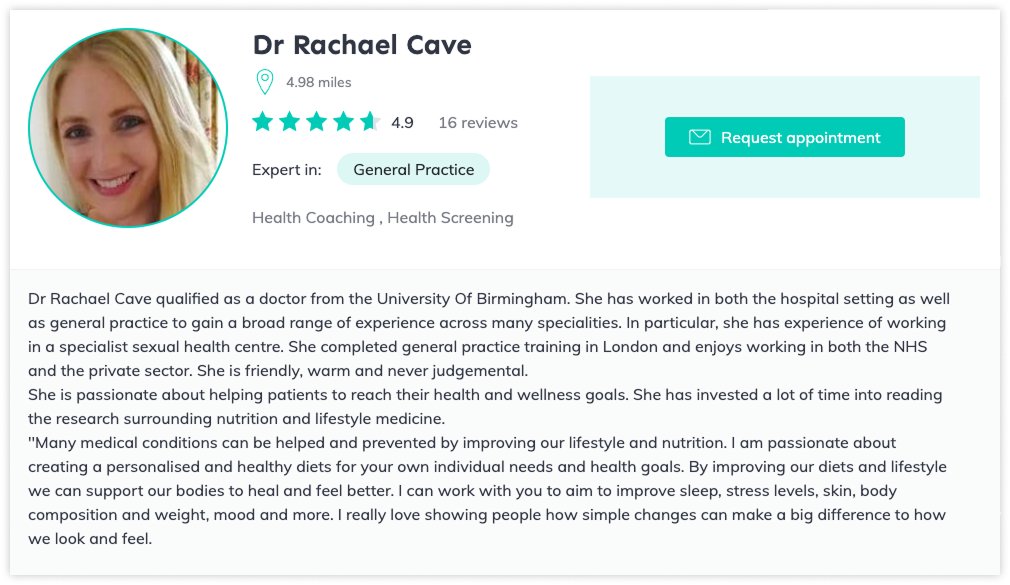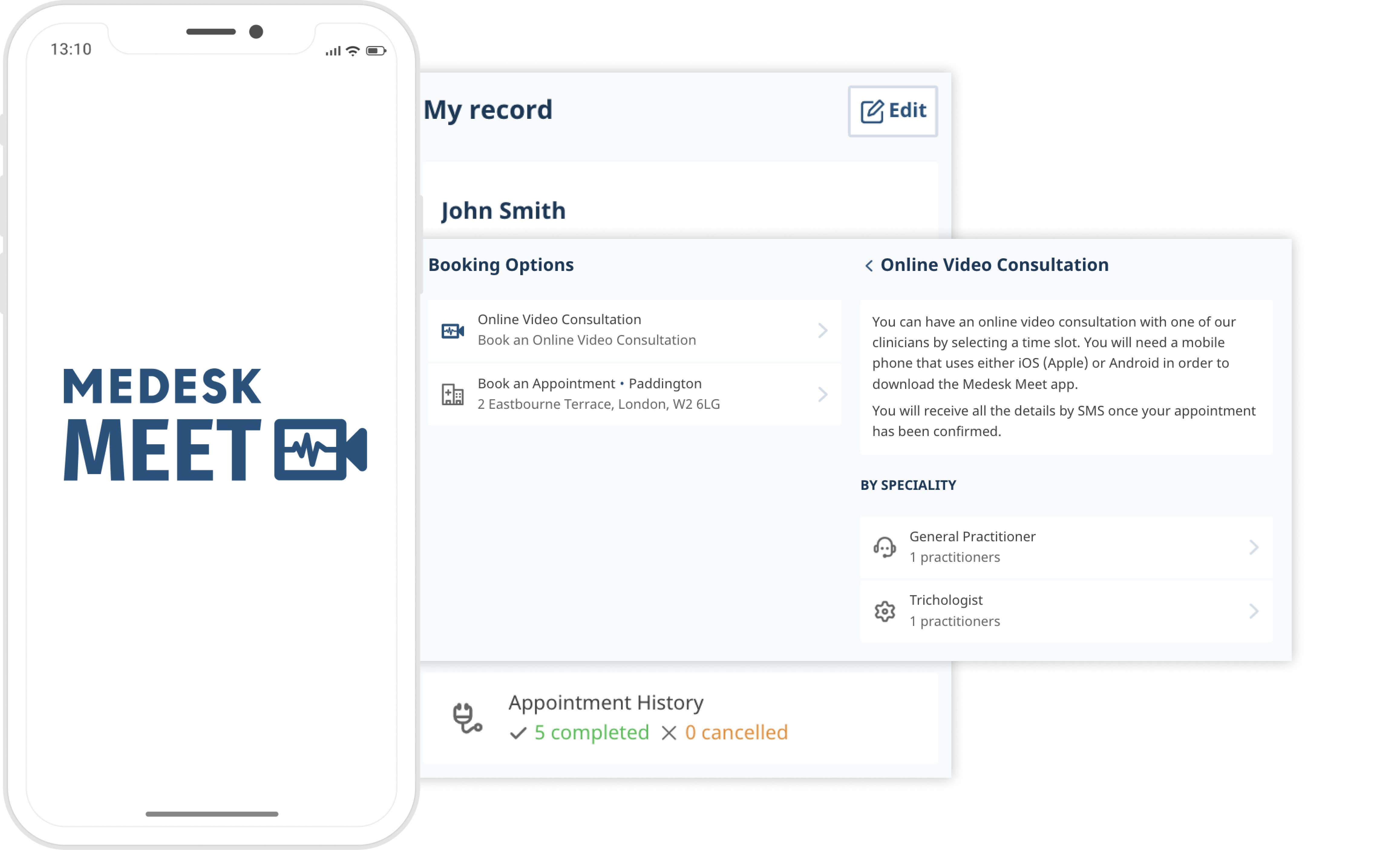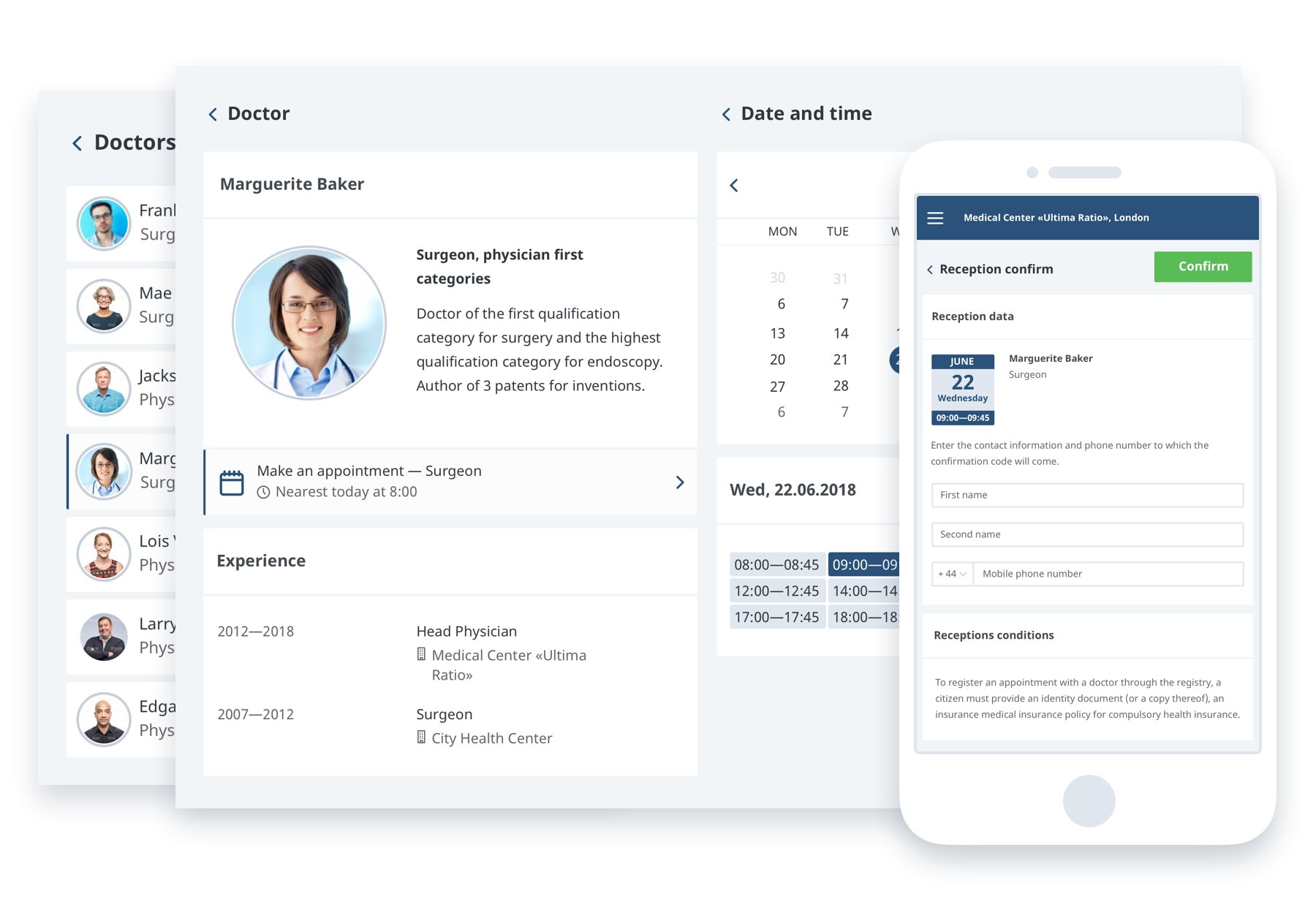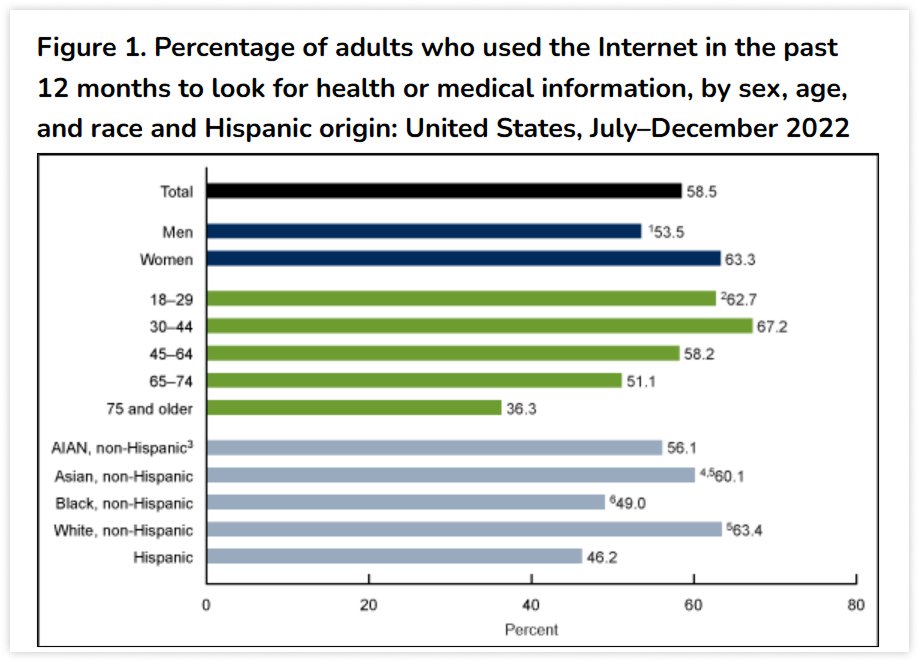Today, traditional effective marketing strategies like word of mouth and fliers are no longer enough to promote your business and attract new clients. The healthcare industry is no exception to this.
To get more patients and keep your clinic profitable, you need to step up your game and use modern marketing techniques.
On the one hand, you’re lucky because there are many different tools and channels to effectively win potential patients: SEO, Google Ads, content marketing, you name it.
On the other hand, finding the most effective way to attract potential new patients to your clinic can be quite a daunting task with so many options available. Not to worry, though—we’re here to help.
In this article, we’ve listed the best ways to attract more patients to your clinic, boost your profits, and promote all the services offered in your medical practice.
Let’s dive right in.
Learn how to simplify your practice workflow and free up more time for patients with Medesk.
Open the detailed description >>How to Use Digital Marketing Tools to Drive Patient Growth
For a healthcare digital marketing company, leveraging digital tools can streamline patient acquisition, enhance engagement, and ensure continuous growth by effectively promoting services like CPR renewal online, making healthcare accessible and compliant for patients.
A strong web presence can help you stand out from your competitors, drive more patients to your clinic, and overall drive better revenue.
Studies indicate that over half of adults in the US use the internet to look up health information, and this trend is increasing in many parts of the world. For instance, in some European countries, over 70% of adults have sought health information online.
Now, there are different types of digital marketing you could take advantage of, the most common of which include:
- Content marketing. Creating content that helps your target audience learn more about their condition or symptoms. But if you’re having trouble getting started, there are some online writing tools available, such as AI reworder & claude.ai, and AI humanizer. These tools assist you in writing informative content that resonates with your target audience and enhances brand awareness.
- Search engine marketing. Running ads on Google Search for keywords related to your clinic.
- Search engine optimization. Optimize your website in such a way that it pops up on page one when people Google “medical clinic.”
- Social media marketing. Keeping an active social media presence, running promotional campaigns, etc. Use LinkedIn to share expert insights and connect with other providers.
- Email marketing. Reaching out to existing patients with special offers and trying to retain them as customers for your clinic. Email marketing can also be leveraged effectively, especially if you have direct email contacts of potential clients. If you're targeting local businesses or trying to locate specific contact information, you could extract emails from Google Maps. Tools that allow this type of extraction can help boost your outreach significantly, especially when combined with a free SMTP server to streamline email delivery.
We’ll cover each of these healthcare marketing channels in more detail a bit further down in the article.
Medesk helps automate scheduling and record-keeping, allowing you to recreate an individual approach to each patient, providing them with maximum attention.
Learn more >>1. Target Audience Segmentation: Reach Your Ideal Patients
Before launching any marketing strategy, define who your ideal satisfied patients are. Segment audiences by age, gender, location, profession, and health concerns to deliver more personalized messages and build trust.
Use patient data from your CRM or surveys to build 3–5 clear patient personas. Here is an example of a patient segmentation table:
| Persona Name | Age Range | Gender | Location | Profession | Health Concerns | Preferred Communication |
|---|---|---|---|---|---|---|
| Busy Professional | 28–45 | Any | Urban areas | Office workers, managers | Stress, back pain, preventive checkups | Email, online booking |
| Young Parent | 25–40 | Mostly female | Suburban neighborhoods | Stay-at-home parents, teachers | Pediatric care, vaccinations, wellness tips | SMS, social media |
| Active Senior | 60+ | Any | Local community | Retired | Chronic disease management, mobility support | Phone calls, newsletters |
| Fitness Enthusiast | 20–35 | Any | City gyms, sports clubs | Trainers, students | Sports injuries, nutrition advice | Social media, QR codes |
| Tech-Savvy Patient | 18–40 | Any | Anywhere (digital-first) | IT, freelancers | Telehealth services, online consultations | Mobile app, chat support |
2. Create a High-Converting Clinic Website That Builds Trust
Your practice website is often the first impression patients have. Ensure it is:
- User-friendly and mobile-responsive
- Compatible with all devices
- Features clear calls to action (book now, contact us)
- Includes patient testimonials, positive reviews, and educational content.
Done right, a website can help you increase patient flow to your clinic by allowing anyone who looks you up to get information about your services and expertise, to contact you, or to learn more about health-related issues straight from professionals.
Make sure that your website is up to modern standards, though. The site you made 10 years ago just doesn't work anymore. Clunky or outdated design or slow load speed are both among the factors that can cause your customers to pick a competitor clinic over yours.

While a well-built, professional website might be a bit expensive, it’s definitely well worth the investment, and using an AI website creator can help reduce costs while maintaining quality. It’s better to build a single quality website once and have it run for years than have to redo it every few years.
We can’t say that messengers are used for promoting your clinic, but they do help you to attract an audience. Patients expect real-time responses. By placing a live chat button on your website, you demonstrate the patient-orientated nature of your practice and your willingness to support people.
However, if you do decide to add a live chat feature, make sure that your colleagues take responsibility for responding in a timely fashion. Ideally, you ought to reply within 15 minutes and set up a chatbot to handle out-of-hours enquiries.
3. Boost Local Visibility with SEO and Generative Engine Optimization (GEO)
Your website should be well-optimized according to Google best practices so that your patients can find your clinic when they look for medical clinics in your area.
Search Engine Optimization (SEO) is the process of optimizing your website to search engine best practices so that Google (or other search engines) ranks your website on top of search results for a given keyword.
The difference between chiropractic clinic websites that rank #1 as opposed to, say, #20, is how well their website is optimized according to SEO principles.
What SEO principles, you might ask? Well, here are some basics:
- Mention your target keyword on the respective page. The target keyword should be mentioned once in Heading 1, Heading 2, and several times throughout the page copy.
- Make your website mobile-friendly. Google rewards websites that are optimized for mobile traffic.
- Have a dedicated page for each target keyword. For each service that you offer, you’d want to have a dedicated page targeting the respective keyword.
- Create an (optimized) Google My Business page. Having a GMB profile allows you to rank on Google Maps, making it more likely for people in your area to discover your clinic.
Another important three letters in 2025 are GEO. Generative Engine Optimization (GEO) is an emerging approach that helps your clinic website stay.
Instead of only trying to rank high on Google, GEO focuses on making your clinic’s content helpful and easy to understand so that it appears in answers generated by AI tools and voice assistants. This means creating high-quality, clear information about your services, patient care, and specialties that both search engines and AI can use to recommend your healthcare practice:

By using GEO, you increase your chances of being suggested when potential patients ask health questions online, helping you attract more patients and improve your online presence naturally. When integrated with tools like a ChatGPT MCP server, practices can also automate helpful responses and improve patient engagement.
4. Leverage Social Media Marketing to Increase Positive Experience
Businesses have long found ways to leverage the power of social media platforms, so it’s only natural that you can also use them to strengthen your online reputation and increase patients.
According to Business Research Insights, the Pharma and Healthcare Social Media Market is expected to reach USD 67.87 billion by 2033.
Tell people about your clinicians, answer questions, publish medical news, and ask your doctors to work on their personal profiles. After all, many patients choose by the doctor, not by the clinic.

Out of the many options out there, Instagram, Facebook, and Twitter are the best platforms to engage with patient referrals. Some ways you can use social media to promote your healthcare clinic are:
- Post relevant content. Publish articles, posts, and other kinds of content that help your target audience learn more about their health problems.
- Boost your posts. Most social media platforms allow you to run ads on them or boost your content pieces to reach a wider audience.
- Build up social proof. You can encourage your existing customers to leave online reviews on social media platforms. You can include your personal and professional details on your digital business card to impress new clients, helping you showcase your credibility and strengthen your social proof.
- Think up unique hashtags for your promotional campaigns and offers and let patients know so they can take advantage.
- Organize giveaways. You can let your customer base know about special offers, promotions, or giveaways via social media.
Beyond articles, expand your educational efforts with videos, FAQs, downloadable guides, and infographics. Patients appreciate informative content that’s visual and easy to understand.
For example, record short videos explaining common procedures or conditions you treat. Or run a monthly Q&A live stream or spotlight a patient success story (with permission).
5. Maximize ROI with Targeted Ads for Healthcare Services
Targeted advertising works via social media. It is a promotional tool that allows you to show specific ad campaigns to certain people based on their gender, age, location, socioeconomic status, marital status, and interests.
Unlike context ads, which tend to work in the case of high demand, targeted ads capture those who might be interested in your services based on hypotheses proposed by marketing specialists.
The main difficulty in setting up targeted ads lies in defining which audience to search for in the first place. No clinic is exactly like any other, and it’s clear the target audience belonging to a plastic surgeon is going to be different from that of a GP.
Nevertheless, there are some general trends that can be relied upon, such as the observation that the people most likely to click a medically-themed advertisement are women over 30. In contrast, men of all ages tend to put off treatment until the last minute and so are much less likely to click a medical ad.
Target, amongst others:
- Those belonging to particular social media groups and competitors’ pages;
- Those with a clear interest in health;
- Geographic regions.
Discover more about the essential features of Medesk and claim your free access today!
Explore now >>6. Keep Your Patients Engage With Email & SMS Marketing
Delivering a quality patient experience is great, but you also need to make sure that they’re engaged with your brand even when they’re not actively being treated in your clinic.
The best way to do this is to utilize a medical CRM and occasionally communicate with your former and current patients. Some ways you can do this are the following:
- Send automated appointment reminders via SMS using secure, HIPAA-compliant tools like Textline, or email. Reminders turn online bookings into actual visits.
![[en] sms connunication](/i/1aEPlH4J0KXGT4JJWVzCfj/9e709bfda37a2084efabc1b1e0b0ad2c/sms_communication.png)
- Update your patients about clinic news via a newsletter.
- Help your patients stay healthy with a general health newsletter, sending them tips related to their health or a specific condition.
- Target patients within specific demographics with special offers. E.g., a 50% off checkup, free consultation, birthday discount, and so on.
Use A/B testing on subject lines to boost open rates.
7. Leverage Online Directories and Patient Review Sites
Your online reputation significantly impacts patient acquisition strategy. If your clinic is new, it’s vital that you encourage your first patients to leave testimonials on review sites. The most popular review portals include:
- Doctify
- Private Healthcare UK
- Healthgrades
- Yelp, and many more.

You can and really should also “plant” reviews yourself by asking patients for permission to post their comments on your profile. The chosen comments should be written in a mildly complimentary style that gives just enough detail to convince the reader.
And of course, don’t forget to answer the reviews even if you see reviews that are less than glowing: it’s an opportunity to perform reputation management and win back a customer.

Publish patient testimonials and success stories on your website, social media, and marketing campaigns. These authentic voices increase credibility, influence prospective patients, and highlight high-quality patient care.
8. Use Q&A Sites and Crowd Marketing to Expand Clinic Awareness
Businesses often get a good return on investment from recommendations made on question and answer sites. Establish expertise by answering patient questions on forums like Quora, Reddit, or local Facebook groups. It builds authority and visibility. Sharing insights through forum submission sites also helps reach a wider audience while providing valuable resources.
By providing a detailed response to a user’s query, you help them (and other users) to solve their problems while telling them about your clinic. The difficulty lies in the fact that you need to give a comprehensive response with links to sources and not just give out recommendations. That is to say, you must include links that direct people towards useful resources like Wikipedia rather than just to your website.
It may also be to your advantage to mention in passing an inferior competitor (whether in service quality or cost). This promotional channel is known as crowd marketing, and its effects can be huge. It works as follows:
- Register yourself on forums, recommendation portals, and question and answer sites.
- Leave a few answers on different topics unrelated to your niche. This is necessary to “warm up” your profile and make it appear more genuine.
- Search for topics and questions that discuss the doctors, clinics, and medical services in your locality.
- Give detailed responses and include a link to your website. Answers should be written with as much empathy as possible.
- Repeat.
It can be worth having a few different profiles on the most popular platforms. Veterans of guerrilla marketing often set up debates between their own accounts so as to make their answers look more convincing.
9. Increase Referrals with Patient and Partner Programs
Encourage your current patients to refer friends and family. Offering small incentives or loyalty rewards can activate this cost-effective growth channel. Data from NHS England shows that in June 2024, there were over 1.6 million referrals made across various healthcare settings.
Create a referral card or digital link patients can easily share.
But don't focus solely on patients: collaborate with non-competing healthcare providers to generate mutual patient referrals. That’s what we do at Medesk:
![[en] partners booking pic](/i/2eLlfo4YtnQS9SuhagK7cG/b3860edca2a78a9c466104e5eba96f81/partner_booking.png)
10. Innovate Patient Interaction with QR Code Marketing
QR Code marketing is an easy way for clinics to share information and connect with patients through a quick scan. Many patients already use an online QR code scanner on their phones, so reaching booking pages, feedback forms, wellness tips, or special offers becomes simple. Placing QR Codes in busy spots like waiting rooms, brochures, or even on social media lets patients reach the information easily. One simple yet powerful way to design eye-catching flyers is to use a flyer maker to match your clinic’s branding and message.
This simple method saves paper and gives patients instant access to what they need, improving patient satisfaction.

With QR Code tools that allow customization and tracking, clinics can create personalized campaigns leading patients to helpful content, forms, or appointment systems. Some tools, like Uniqode, also show which links patients use most, helping clinics plan better campaigns and share the right information at the right time.
11. Offer Telemedicine and Online Booking to Attract Busy Patients
Most people today prefer to do everything from their phones, including shopping, working, and even looking for dates. So, it shouldn’t surprise you they have the same preferences when it comes to booking their healthcare appointments.
There are 2 ways you can take advantage of this.
For one, you can start offering telemedicine services. By using a platform like Medesk, your clinic can offer online consultations to patients that otherwise would not be able to visit your clinic physically. You can place booking links directly on your social media pages, your website, and in newsletters, and enhance accessibility by incorporating tools like The QR Code generator.

Alternatively, you can also set up an online patient portal. This allows for all sorts of amazing features, like letting your patients book or cancel appointments online, check their prescription, check their diagnosis, treatment plans, and so on.
Online booking comes with a number of other benefits, such as reducing cancellations and no-shows by allowing patients to book appointments when it’s most convenient for them.

If you combine both telehealth and client portal within your clinic, you will feel confident that new patients see your services online and make appointments and follow-ups without any extra work on your part.
Even if you are not an expert in marketing, the simple yet effective functionality of practice management software will turn online bookings into real money and a high retention rate.
Discover more about the essential features of Medesk and claim your free access today!
Explore now >>12. Streamline Growth Using Practice Management Software
If you want to get more patients without phone calls, waiting, or extra stress, start a free trial of the Medesk Practice Management Software (PMS). What you will receive:
- Learn which marketing channels work best, stop guessing, and start seeing real results.
- Increase conversion from website visits to appointments by at least 10% (Medesk internal data study).
- Create your website without additional investments in a designer and marketer.
- Attract new patients without overloading administrators and doctors.
You can implement these tools into your practice thanks to integrations with social networks, local SEO listings, easy-to-use integrated widgets for online appointments with a calendar, automated tags for new patients, reminders, and other features. All of them are available from day one of the trial period.
Discover more about the essential features of Medesk and claim your free access today!
FAQs: How to Attract Patients to Your Clinic in 2025
#1. What is the most effective way to attract new patients?
→ There’s no single best way. A mix of strategies, such as digital marketing, patient segmentation, online booking, and social media engagement, works best to draw in and retain patients.
#2. How does having a good website help my clinic?
→ Your website is often the first impression patients get. A modern, mobile-friendly site with clear booking options and helpful content builds trust and encourages patients to choose your clinic.
#3. What is GEO and how does it differ from SEO?
→ Generative Engine Optimization focuses on making your content clear and helpful so it appears in AI-generated answers and voice assistant responses, increasing your visibility in new search formats. SEO makes your website easier to find on Google. When patients use local search for services in your area, a well-optimized site helps you appear at the top of results, attracting more visitors.
#4. What are referral programs and how do they work
→ Referral programs reward current patients for recommending your clinic to friends or family. They are cost-effective and can significantly increase new patient numbers.
#5. How do clinics use practice management software to get more patients?
→ Software like Medesk helps manage appointments, track marketing results, and automate communication, making patient acquisition easier and more efficient.



